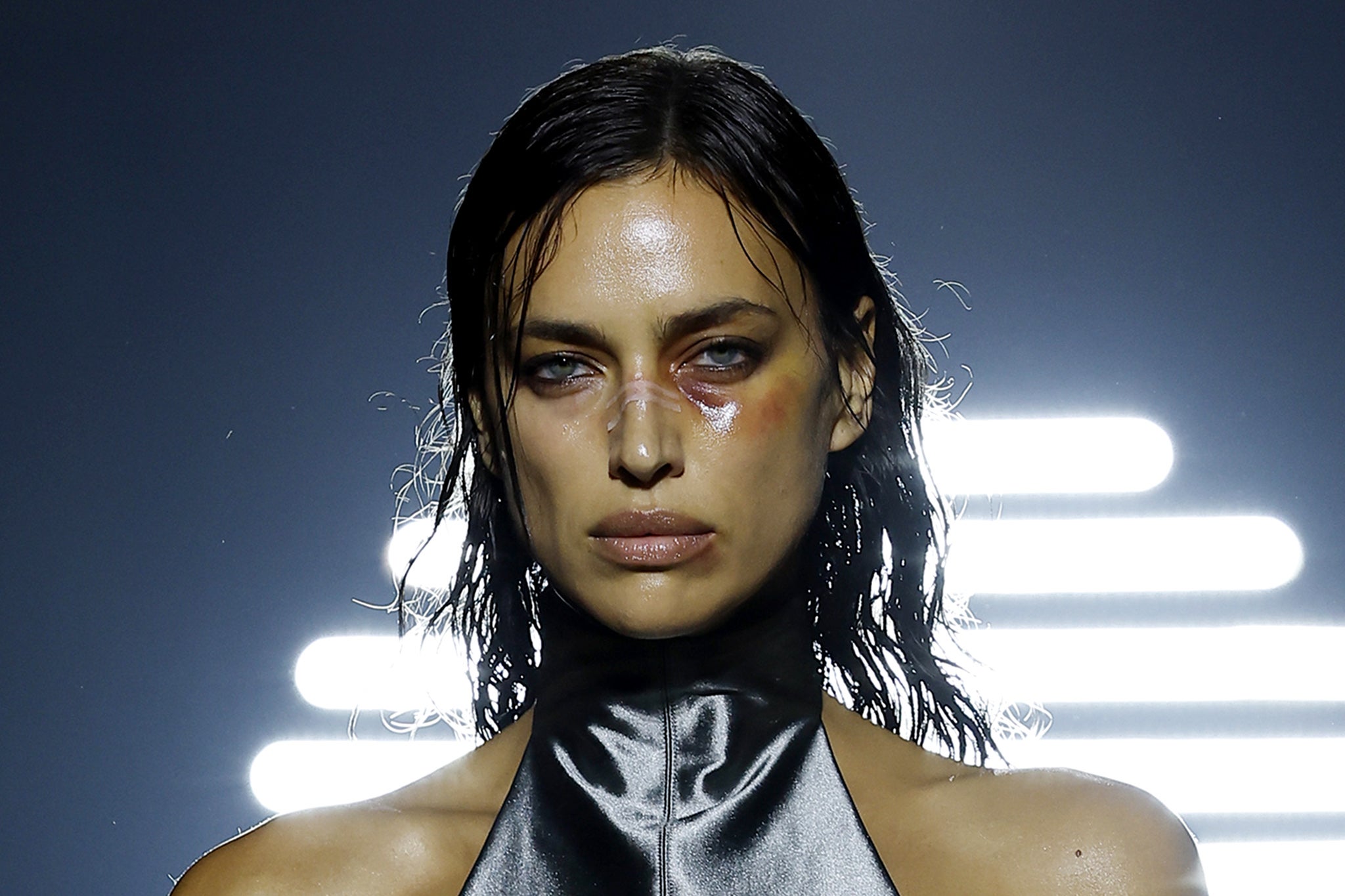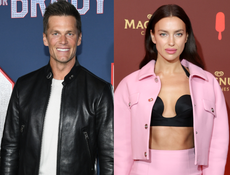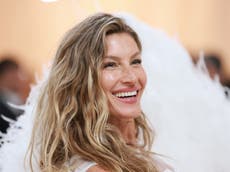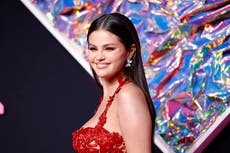A fake black eye and a ‘cut lip’ on the runway – when did domestic violence become fashionable?
How could Mowalola send a supermodel down the catwalk modelling fake facial injuries? All too easily, writes Katie Edwards...


As if we needed any more evidence that violence against women is normalised, trivialised and dismissed, supermodel Irina Shayk walked the runway for Mowalola at London Fashion week sporting a shiner and a bruised lip. Violence against women – how couture.
I wish I could say that glamorising gender-based violence is mercifully rare in fashion these days, but it’s not. Women’s battered bodies are a trope in the fashion industry from the catwalk to big brand ads. Last October, Doja Cat cheerfully showed us how to recreate the black eye and busted face look she wore to the Balenciaga Spring 2023 show. She even told Vogue: “This is my first fashion week, so I’m having a great time—but it’s definitely kicking my ass. I wanted to do something where I have a black eye, split nose, and split lip. But my lashes are really pretty—we made it glam at the same time.”
Mowalola tweeted: “We run from pain but we need pain to survive”. And, last year, Chanel accessorised its collection with fake facial bruising. Tres elegant.
Violent imagery isn’t a new trend, either. Sexual violence has been a mainstay of fashion advertising for decades already. From Dolce and Gabbana’s notorious “gang assault” ads in the early noughties, to Jimmy Choo’s 2007 campaign featuring music legend Quincy Jones sitting on the edge of an open car boot, holding a spade – seemingly ready to bury the corpse of model Molly Sims, whose prone body lies next to him.
Messed up, eh? And there’s so much more. The stalker is a regular image in fashion advertising, as is the voyeur – positioning the viewer as a peeping-Tom peering through keyholes at unsuspecting women, as exemplified by a 2003 campaign for Elle McPherson Intimates. Then, of course, there are the perfume ads that suggest that their fragrance gives women a dangerous, even deadly appeal: a take on the myth that sexual assault is about overwhelming sexual desire, rather than a violent act of power and control.
Giving supermodels a fake black eye is absolutely reprehensible. What an insult to victims of #domesticviolence seeing injuries like this glamorised for public consumption. @MOWALOLA_ should have known better, & #IrenaShayk should have just said NO! https://t.co/Q8CEDmpYYg
— Aisha Ali-Khan (@aak1880) September 17, 2023
So, we know that the fashion industry has form for capitalising on violence against women… but what could possibly justify Shayk’s look at a post-MeToo era London Fashion Week? What motivation could there be for sending a woman down a catwalk with a black eye, a bruised lip… and a T-shirt featuring the late rapper TuPac Shakur who, in 1995, was convicted of sexually abusing a fan? Is it an incisive comment on fashion’s problem with male violence against women? Haven’t we seen enough real-world violence to warrant not seeking it out as entertainment?
Gender-based violence is an insidious, apparently unavoidable part of our experience; unfortunately, so is having those experiences dismissed, undermined and minimised.
Abuse of women is presented as a normal part of women’s lives. Just witness the number of middle-aged women who don’t see the problem with Rubiales kissing footballer Jenni Hermoso at the World Cup.
Groping, grabbing, cat-calling and flashing are all routine experiences for many women. We’ve been told that they’re “no big deal” and that complaining makes us the problem – we’re the ones with no sense of humour, or we’re attention-seeking, or we’re lying, or we’re exaggerating, or we were asking for it.
And when violence against us is minimised or portrayed as “cool”, no wonder so many women have accepted and internalised the idea that we should put up, shut up, and stand by – even celebrate – alleged and convicted abusers.
I’d like to say that Irina Shayk’s domestic violence chic was most likely an ill-judged protest about fashion’s complicity in the abuse of women. After all, the fashion industry is mired in sexual abuse and gender-based violence scandals. Is Shayk’s battered face, for instance, intended to represent a “fashion victim”?
A disturbing, unnerving, unflinching look in the mirror for an industry that makes billions off the back of exploited and abused garment workers. Or an allusion to fashion’s “darkest secret”: the many models who allege they’ve been groomed, raped and sold by agents? An attempt at visual solidarity with the many models who allege they’ve been assaulted by famous photographers?
I’d like to say all this, but I can’t – because I think it’s rubbish. I think the fashion industry continues to glamourise violence against women because it gets them headlines. Violent imagery makes brands look rebellious, provocative and counter cultural.
This won’t be the last time that a bruised face is portrayed as an edgy fashion accessory on the catwalk – but surely it should be the last time that a famous, influential woman like Shayk supports the fetishisation of violence against women by lending her name and face to a brand that seems willing to throw women under the bus for the sake of publicity?



Join our commenting forum
Join thought-provoking conversations, follow other Independent readers and see their replies
Comments